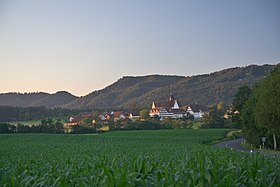Kappel am Albis
| Kappel am Albis | |
|---|---|
| State : |
|
| Canton : |
|
| District : | Affoltern |
| BFS no. : | 0006 |
| Postal code : | 8926 Kappel am Albis 8926 Hauptikon 8926 Uerzlikon |
| Coordinates : | 682 439 / 231456 |
| Height : | 573 m above sea level M. |
| Height range : | 463–621 m above sea level M. |
| Area : | 7.92 km² |
| Residents: | 1157 (December 31, 2018) |
| Population density : | 146 inhabitants per km² |
|
Proportion of foreigners : (residents without citizenship ) |
16.7% (December 31, 2018) |
| Mayor : | Jakob Müller ( independent ) |
| Website: | www.kappel-am-albis.ch |
|
The monastery seen from the south |
|
| Location of the municipality | |
Kappel am Albis (officially called Kappel until 1911 ) is a political municipality in the Affoltern district (also Knonauer Amt or Säuliamt) in the canton of Zurich in Switzerland .
geography
Kappel is located on the southwest slope of the Albis south of Hausen in the Jonental . In addition to Kappel itself, the districts of Hauptikon and Uerzlikon also belong to the municipality. The neighboring communities in the canton of Zurich are Knonau , Mettmenstetten , Rifferswil and Hausen am Albis, in the canton of Zug Baar and Steinhausen .
history
Evidence of settlement can already be found in the area of today's municipality for the Bronze Age. There is also evidence of a Roman manor on the parish of the municipality. But Kappel first became tangible in 1185, when the monastery of the same name , in which the origin of today's community lies, was founded. The monastery was able to expand its property again and again in the following centuries and concluded a castle rights contract with Zug in 1344 and with Zurich in 1403 . In the course of the Reformation , the clashes of which reached a climax in the two Kappel Wars (1529 and 1531), the monastery was dissolved. Kappel was subordinated to the Landvogtei Knonau and the monastery property was administered by city officials from Zurich, who also drew the tithe in the surrounding hamlets.
With the invasion of the French in the year Kappel was assigned to the district of Mettmenstetten , with the end of the Helvetic Republic in 1803 to the district of Horgen , and then to come back to the newly formed Knonau Oberamt ( Knonau district from 1830 ). The municipality of Kappel has been part of the Affoltern district since 1837 .
coat of arms
- Quartered: 1 and 4 in black a bar cut from red and silver, 2 in gold a black wall anchor cross, 3 in blue the north view of a silver church with aisle, transept and crossing tower, red roofs and black windows.
population
| Population development | |
|---|---|
| year | Residents |
| 1634 | 256 |
| 1799 | 438 |
| 1850 | 743 |
| 1900 | 697 |
| 1980 | 567 |
| 2000 | 865 |
Attractions
The Kappel Monastery on an engraving by David Herrliberger, 1741
Personalities
- Josias Simler (1530–1576), theologian and historian
literature
- Bernhard Schneider : From the monastery estates to the independent community. Kappel am Albis through the ages Chronos Verlag Zurich 1988, ISBN 3-905278-29-4 .
- Thomas Huonker, Peter Niederhäuser: 800 years of Kappel Monastery: Abbey, poor institution, Orell Füssli Education Center Zurich 2008, ISBN 978-3-280-06074-2 .
- Hermann Fietz: The art monuments of the canton of Zurich, Volume I: The districts of Affoltern and Andelfingen. (= Swiss art monuments. Volume 7). Edited by the Society for Swiss Art History GSK. Bern 1938. DNB 365803030 .
Web links
- Official website of the municipality of Kappel am Albis
- Statistical data for the municipality of Kappel am Albis
- Martin Leonhard: Kappel am Albis. In: Historical Lexicon of Switzerland .
- Magdalen Bless-Grabher: Kappel (monastery). In: Historical Lexicon of Switzerland .
Individual evidence
- ↑ Permanent and non-permanent resident population by year, canton, district, municipality, population type and gender (permanent resident population). In: bfs. admin.ch . Federal Statistical Office (FSO), August 31, 2019, accessed on December 22, 2019 .
- ↑ Data on the resident population by home, gender and age (community profile). Statistical Office of the Canton of Zurich, accessed on December 22, 2019 .






